
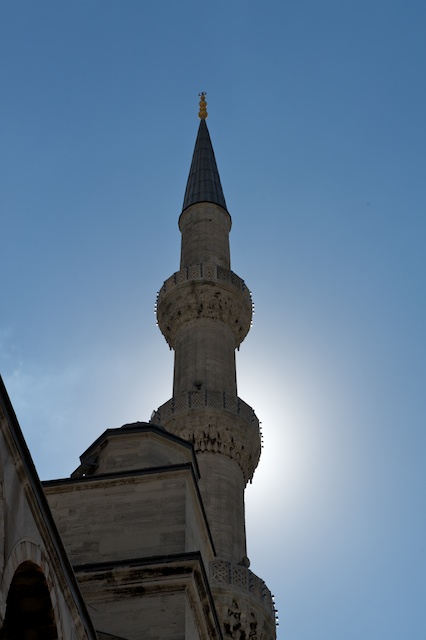
This trip, we are starting off in Istanbul, Turkey! Donnie, my lovely wife, had already been 3 weeks in Turkey with her cousins and her younger son, Chris, visiting a bunch of villages in eastern Turkey where their grandparents had lived. For a fascinating set of stories about this adventure, go to her web site...
I was now going to join her in Istanbul, and then see some other parts of Europe.
Usually, when I start these travel stories, I rant for pages about the New York traffic, and the airports, and the airlines, etc. I'll try to keep the rant short this time.
My trip to the airport, using our local limo service, was quick, efficient, and perfect. The usual rigamarole at the airport was, usual. Nothing worse. The plane, amazingly, left on time, and 9 and ½ hours later, arrived a little early. The only downside was the food on the flight, which was bad, even compared to the usual standards, but that's normal nowadays, given that I was flying with a greedy US air carrier. (We were using up our frequent-flyer miles to get these tickets, so we won't need to fly with this carrier any more. YAY! The carrier, who will not be named, for fear of lawsuits, might be called Gamma Airlines).
Anyway, after the long flight, I arrived in Istanbul's Ataturk airport. As soon as I got out of the jetway, I was shocked, and saddened. Not for the Turks, but for the Americans, and particularly, the New Yorkers. The airport terminal I had left from, in JFK, one of the largest and busiest airports in the US, was dirty, in need of repair, and in many ways a disgrace. Istanbul's Ataturk airport was spotless! More than spotless. The floors shined like mirrors. Everything was new, clean, shiny, and perfectly maintained. Everything! How could this be? Many Americans constantly say that America is the best country in the world. Ah well.
The usual trials and tribulations of getting through the airport were efficient and easy. Donnie, who, as I have already said, was already in Istanbul, had arranged with our hotel to pick me up, and the driver was there and waiting. The trip from the airport to our hotel was interesting since after traveling for about 20 minutes on a highway, the driver turned into an area called Sultanahmet, which is the old area of Istanbul, and contains most of the major attractions, along with our hotel. The interesting part was that the area is honeycombed with lots of narrow, twisty little streets, all the same. (Devotees of the archaic computer game “Hunt the Wumpus” might recognize that phrase!). When I say narrow, I mean narrow. All the streets were one car wide, and sometimes had parked cars or other obstacles blocking the way. Also, even though the streets were only wide enough for one car, they were not one-way streets!
Anyway, I arrived at the hotel, which was a pretty white building in a small street containing offices and bookstores, and went in. The staff was extremely friendly and helpful, which Donnie had told me would be the case. The desk clerk, a young Turkish man, spoke reasonably good English, which was very helpful, since my Turkish vocabulary consists of zero words. He told me that my wife had been expecting me to arrive a bit later than I did, so she and her cousin Roseanne had gone out for a while, but they would probably be back soon, and would I mind waiting in the lobby a bit. While waiting, I sent Donnie a text message on her cell phone to let her know that I was in the hotel, and a minute or two later, a young, pretty, hotel employee came up to me holding a tray containing a champagne flute of orange juice, and a china plate containing a piece of “Turkish Delight”, a popular turkish candy. Wow! What a reception.
A very short time later, Donnie and Roseanne arrived, and after switching Donnie's belongings from her old, single room to a double room, we decided to go out.
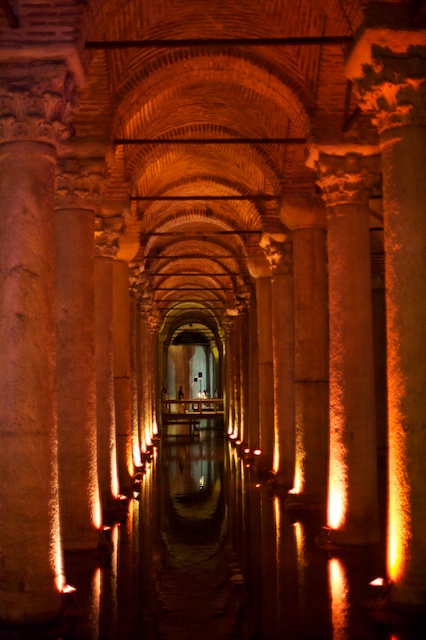 The three of us walked a couple of blocks from the hotel, and Donnie
suggested that we see the Byzantine Basilica Cistern, which was only
another block away. The cistern is a vast underground “room” containing
many ancient stone columns, with fancy capitals, used to collect water
during the Byzantine period. The cistern was built in the year 532
a.d.! It was amazing. After spending much time down in the cistern,
taking a lot of pictures, even though it was quite dark, we emerged into
the light and, walking a few more blocks, passed the Hagia Sophia, a
very old, very beautiful, very famous early Byzantine church. Donnie
suggested we see it another day, since both she and Roseanne had already
seen it, and there was a long line to get in. We determined that it
would be closed the next day, Monday, but would be open on Tuesday.
The three of us walked a couple of blocks from the hotel, and Donnie
suggested that we see the Byzantine Basilica Cistern, which was only
another block away. The cistern is a vast underground “room” containing
many ancient stone columns, with fancy capitals, used to collect water
during the Byzantine period. The cistern was built in the year 532
a.d.! It was amazing. After spending much time down in the cistern,
taking a lot of pictures, even though it was quite dark, we emerged into
the light and, walking a few more blocks, passed the Hagia Sophia, a
very old, very beautiful, very famous early Byzantine church. Donnie
suggested we see it another day, since both she and Roseanne had already
seen it, and there was a long line to get in. We determined that it
would be closed the next day, Monday, but would be open on Tuesday.
We continued walking another couple of blocks and came to the Topkapi Palace (for you old film buffs, yes, the same Topkapi palace! We wondered where Melina Mercouri, Maximilian Schell, and Peter Ustinov were).
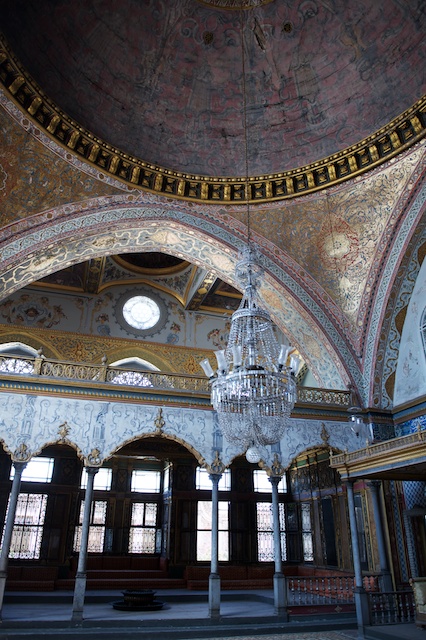
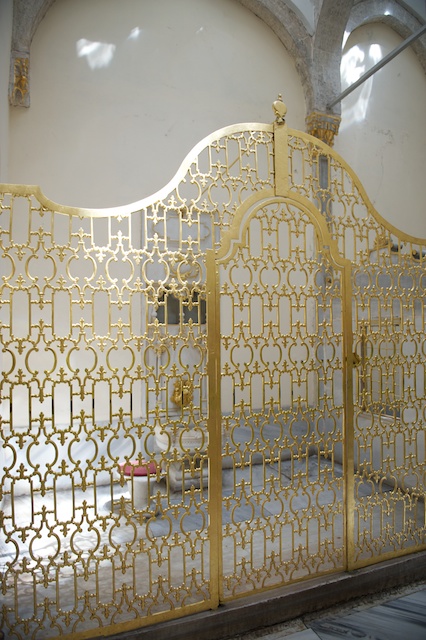 Topkapi palace was the palace of the Ottoman Sultans from 1465 until
1856! There are many buildings inside a parklike compound. The most
impressive one that we saw, however, was the Harem. Ok guys, stop
snickering. Harem just means private. This was the residence of the
Sultans' wives and concubines. The architecture and décor were
incredible: Very ornate, very beautiful, and, obviously, very expensive!
Also, it was huge. It had to have living quarters for the wives,
concubines, the children, the servants, the support staff (quite a few
hairdressers, I would imagine) and the eunuchs who guarded the whole
thing. It took us quite a while just to see the Harem.
Topkapi palace was the palace of the Ottoman Sultans from 1465 until
1856! There are many buildings inside a parklike compound. The most
impressive one that we saw, however, was the Harem. Ok guys, stop
snickering. Harem just means private. This was the residence of the
Sultans' wives and concubines. The architecture and décor were
incredible: Very ornate, very beautiful, and, obviously, very expensive!
Also, it was huge. It had to have living quarters for the wives,
concubines, the children, the servants, the support staff (quite a few
hairdressers, I would imagine) and the eunuchs who guarded the whole
thing. It took us quite a while just to see the Harem.
Then we went to the Treasury, where they keep the jewels and lavish gifts from various heads of state to the Sultans. No Pictures allowed, of course. How about a diamond the size of a hen's egg! Seriously, there was a diamond that, if you threw it at somebody, it would cause serious injury. There was also a room containing some ancient artifacts, some of which I had a hard time believing in, such as Moses' Staff, and an actual footprint of Mohammed. It couldn't possibly just be a stick and somebody else's footprint, could it?
After spending a few hours at Topkapi, we went back to our hotel for a while to rest and recover, and then went out again later to have dinner and explore a bit more. During our explorations we came upon Sultanahmet park, a nice grassy park area near the Hagia Sophia, and Topkapi. The park was absolutely packed. Filled to the brim, mostly with families, sitting on the grass, usually in circles, with food spread out between them. But they weren't eating! It was Ramazan. Ramazan, called Ramadan elsewhere in the Muslim world, is a month-long holiday during which the practicing Muslims fast between sunrise and sunset. The families were waiting for the official announcement of sunset so they could break their fast and finally have something to eat. One of the things we found out about Ramazan is that, not only can't they eat, but they can't even have water! In a very hot country such as Turkey, this sounded most difficult and even dangerous to us.


Curiously, there were only a few kinds of food being sold from carts. Corn carts were all over the place. There were also carts selling pretzels, and something that looked identical to a Bagel! The latter seemed to only be selling to tourists, though. I wanted to try a bagel at some point, but I never got around to it.
One thing that Donnie noticed was that, even though there were thousands of people in the park, after dark, nobody was rowdy, nobody was obnoxious. It felt very peaceful and safe. I pointed out that this might be because most of the people there were families, were religious, and nobody was going to drink alcohol and get drunk.
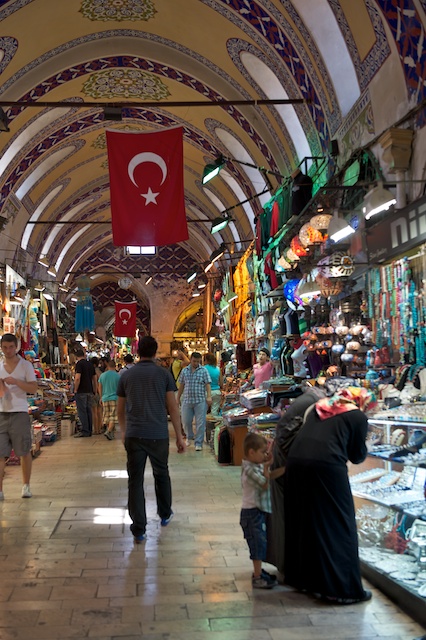
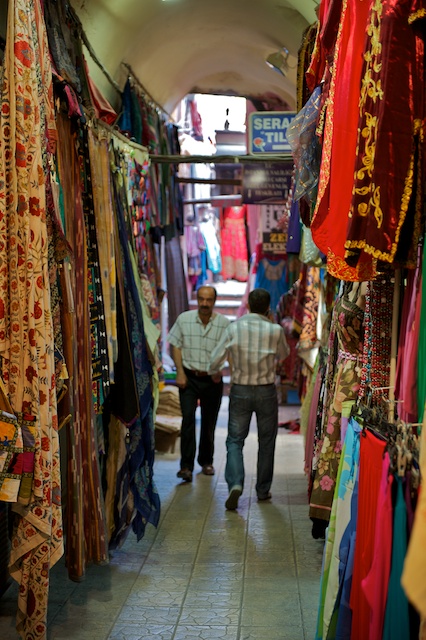 The next morning was our day to visit the bazaars. The Istanbul Grand
Bazaar and the Spice Bazaar. The Grand Bazaar is a huge collection of
tiny shops, all under one roof, connected by many corridors which were
probably once streets. It has domed roofs, some of which were decorated
inside, and literally hundreds of little stalls, containing everything
from genuine antiques to clearly tourist souvenir junk (mostly the
latter). Neither Donnie or I are junk collectors, (or, at least, we
are trying to cut down) and so our main
reason for visiting the bazaar was to take photographs, which we
definitely did.
The next morning was our day to visit the bazaars. The Istanbul Grand
Bazaar and the Spice Bazaar. The Grand Bazaar is a huge collection of
tiny shops, all under one roof, connected by many corridors which were
probably once streets. It has domed roofs, some of which were decorated
inside, and literally hundreds of little stalls, containing everything
from genuine antiques to clearly tourist souvenir junk (mostly the
latter). Neither Donnie or I are junk collectors, (or, at least, we
are trying to cut down) and so our main
reason for visiting the bazaar was to take photographs, which we
definitely did.
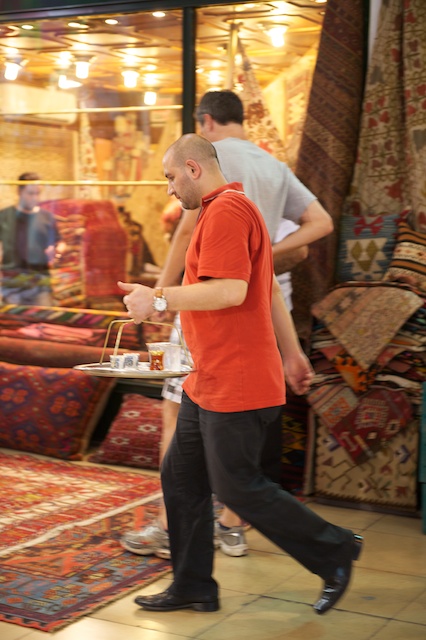
The Bazaar is like a small city. There were banks inside, and a mosque. There were restaurants and snack bars, and many of the merchants would offer you tea (Chai in Turkish) if you came into their shop. There were runners who delivered the Chai.
Now I need to explain the basic marketing technique used by shopkeepers, street vendors, restauranteurs, and others in Istanbul. It is to accost and pester you as much as possible. Whenever you pass a shop, or street vendor, or restaurant, the proprietor will greet you in whatever language he assumes you speak, asking you to buy something or come eat. If you make eye contact in any way, or just point to something he is selling you will get a 10 minute sales pitch. Nothing can stop it, Saying no firmly doesn't work. Walking away doesn't always work, since they sometimes follow you. When restaurant owners keep asking us to come in to their restaurant and eat, even saying that we just ate elsewhere elicits the response “You still look hungry. Come eat something”. I finally resorted to playing deaf, dumb, and stupid, so that I gave absolutely no response and pretended that I didn't hear anything. That seemed to work best. The shopkeepers in the Grand Bazaar were actually less aggressive than the ones outside. I never, however, felt threatened or intimidated. Most of the time they were smiling, and seemed to take the whole give-and-take as a game, or even a joke.
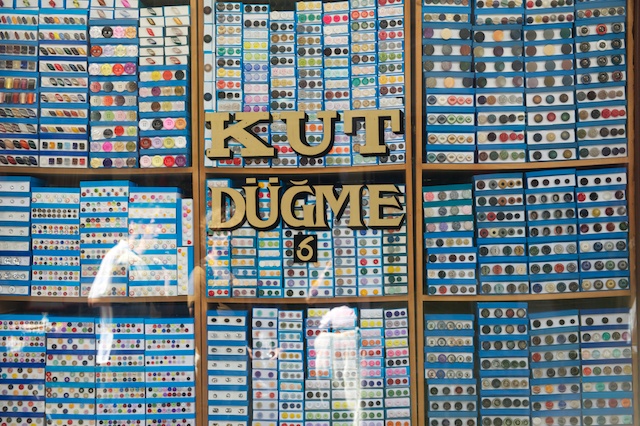
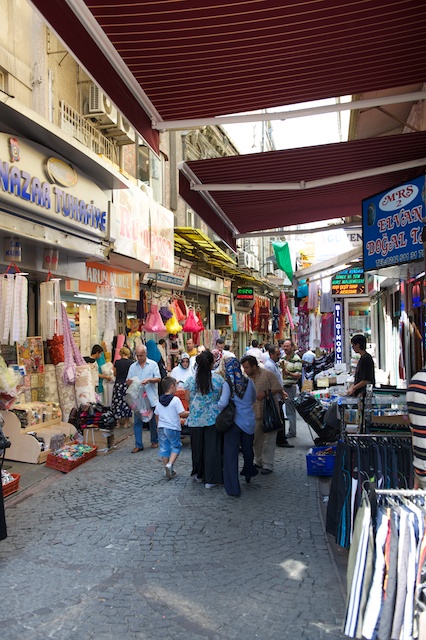 After taking too many pictures in the Grand Bazaar, we left and started
walking toward the Spice Bazaar. On our way, we passed by many, many
little shops on the outside of the bazaar, selling the usual junk, until
we noticed more and more of the shops contained cloth, thread, and other
textile-related items. We were now in the textile area, and there were
hundreds of little shops selling cloth of every imaginable description,
and shops that sold nothing but buttons, or just thread, etc. Amazing.
This continued for many blocks.
After taking too many pictures in the Grand Bazaar, we left and started
walking toward the Spice Bazaar. On our way, we passed by many, many
little shops on the outside of the bazaar, selling the usual junk, until
we noticed more and more of the shops contained cloth, thread, and other
textile-related items. We were now in the textile area, and there were
hundreds of little shops selling cloth of every imaginable description,
and shops that sold nothing but buttons, or just thread, etc. Amazing.
This continued for many blocks.
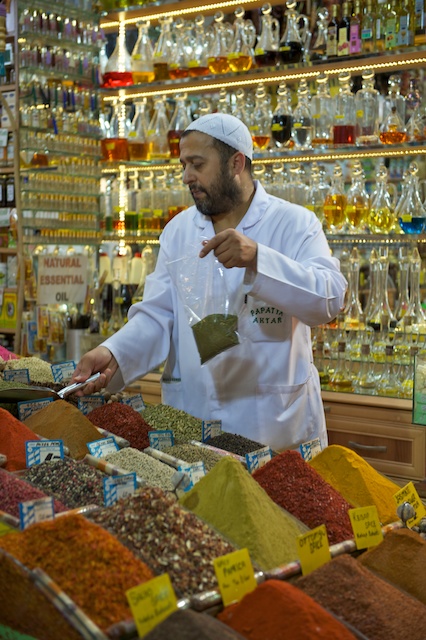 We then found the Spice Bazaar. Again
lots of little shops under one domed roof, connected by lots of
corridors, but most selling foodstuffs. Spices, sweets, nuts, etc. A
great picture opportunity.
We then found the Spice Bazaar. Again
lots of little shops under one domed roof, connected by lots of
corridors, but most selling foodstuffs. Spices, sweets, nuts, etc. A
great picture opportunity.
By this time we were very tired, and very hot, and decided to go back to our nice, air conditioned hotel room. Since we were fairly far from the hotel, and near to a tram stop, we used the very modern, very efficient, ultra-clean, inexpensive tram system. Once again, I am sad for the U.S.
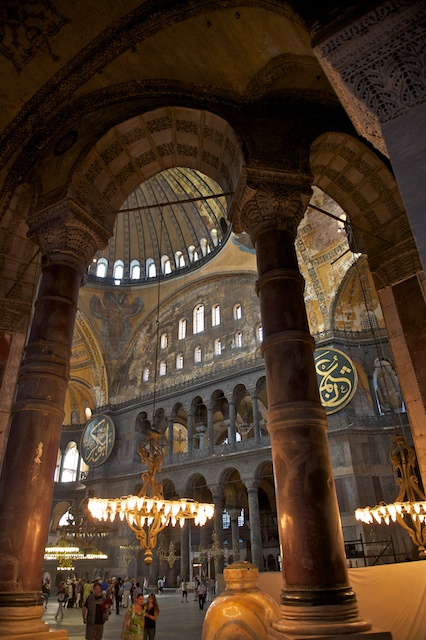
 The next morning we decided to visit the two most famous places in
Istanbul: The Hagia Sophia, and the Blue Mosque.
The Hagia Sophia was originally a Byzantine church built by the emperor
Justinian in the year 532 a.d. That's old! Then, in 1453, after the
conquest of Constantinople (The original name of Istanbul), it was
converted to a Mosque. Then in 1935, the first Turkish president,
Ataturk, had it converted to a museum, which it remains. Inside it
contains remnants of Christian and Muslim worship, but as an early piece
of monumental architecture, it is amazing.
The next morning we decided to visit the two most famous places in
Istanbul: The Hagia Sophia, and the Blue Mosque.
The Hagia Sophia was originally a Byzantine church built by the emperor
Justinian in the year 532 a.d. That's old! Then, in 1453, after the
conquest of Constantinople (The original name of Istanbul), it was
converted to a Mosque. Then in 1935, the first Turkish president,
Ataturk, had it converted to a museum, which it remains. Inside it
contains remnants of Christian and Muslim worship, but as an early piece
of monumental architecture, it is amazing.
 What is most amazing is that
slowly the museum restorers are uncovering original Byzantine mosaics
that were covered during the conversion to a Mosque. These are
incredible. We took a lot of pictures! I still remember my professor
of Art 101 back in Queens College in the early 60's talking about the
Hagia Sophia.
What is most amazing is that
slowly the museum restorers are uncovering original Byzantine mosaics
that were covered during the conversion to a Mosque. These are
incredible. We took a lot of pictures! I still remember my professor
of Art 101 back in Queens College in the early 60's talking about the
Hagia Sophia.
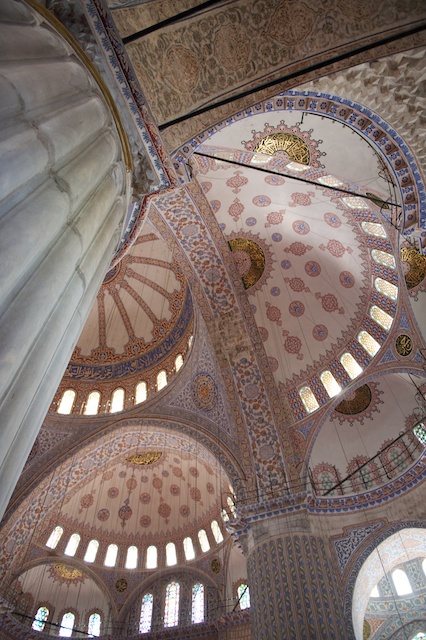 After the Hagia Sophia, we went to the famous Blue Mosque, which is very
close by. It is still a working Mosque, so tourists are not allowed in
during prayers, and when allowed in, women must cover their bare
shoulders and legs, and everyone must remove their shoes. The have
scarves to loan to the women to cover up, and plastic bags for people to
carry their shoes in. The building isn't blue, nor is much of the décor
inside, but it is called the Blue Mosque because of the blue decorative
tiles that cover the inside. Donnie, in particular, loves these tiles.
She asked if we could do our bathroom at home using them. I suggested
black instead, with perhaps an image of Spiderman or at least The “Green
Lantern”. I think we'll probably leave it as is (white painted walls).
After the Hagia Sophia, we went to the famous Blue Mosque, which is very
close by. It is still a working Mosque, so tourists are not allowed in
during prayers, and when allowed in, women must cover their bare
shoulders and legs, and everyone must remove their shoes. The have
scarves to loan to the women to cover up, and plastic bags for people to
carry their shoes in. The building isn't blue, nor is much of the décor
inside, but it is called the Blue Mosque because of the blue decorative
tiles that cover the inside. Donnie, in particular, loves these tiles.
She asked if we could do our bathroom at home using them. I suggested
black instead, with perhaps an image of Spiderman or at least The “Green
Lantern”. I think we'll probably leave it as is (white painted walls).
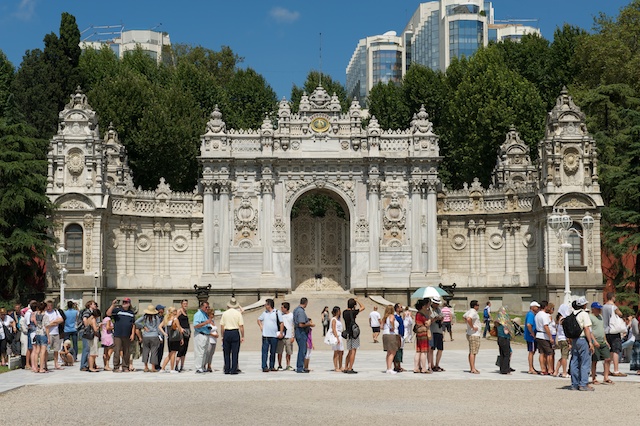 After visiting the Blue Mosque, Donnie suggested visiting a place that
her son Chris had visited on his own two weeks earlier and had said was
very impressive: The Dolmabahce Palace. Visiting the palace involved
walking several blocks to the nearest tram station, and taking the tram
to the last stop, and then walking several blocks, during the hottest
part of the day. When we got to the palace, we had to stand in line for
about 10 or 15 minutes, in the sun, to buy tickets, and then once inside
the palace grounds (which were very beautiful), we found that we had to
stand in line again to get inside the palace itself, since the palace
visit required guided tours which meant that they let in about 30 people
at a time and then waited for the next group. So we ended up waiting again about
a half hour in the hot sun and finally were let in to the palace.
After visiting the Blue Mosque, Donnie suggested visiting a place that
her son Chris had visited on his own two weeks earlier and had said was
very impressive: The Dolmabahce Palace. Visiting the palace involved
walking several blocks to the nearest tram station, and taking the tram
to the last stop, and then walking several blocks, during the hottest
part of the day. When we got to the palace, we had to stand in line for
about 10 or 15 minutes, in the sun, to buy tickets, and then once inside
the palace grounds (which were very beautiful), we found that we had to
stand in line again to get inside the palace itself, since the palace
visit required guided tours which meant that they let in about 30 people
at a time and then waited for the next group. So we ended up waiting again about
a half hour in the hot sun and finally were let in to the palace.
The Dolmabahce Palace was built in the 1850's as a palace for the Sultan and his family, after it was decided that Topkapi was too old. Being a Victorian-era 1850's palace, it was very similar to many other European palaces we had seen. Lots of French-style décor, lots of Victorian furniture. Similarly to Topkapi, you had to pay one fee to visit the palace, and another fee to visit the Harem. We did both. The palace part had some quite spectacular sights, especially the Crystal Staircase and the Grand Ceremonial Hall. Unfortunately, no photographs were allowed. I'll omit my ranting about this! The Harem part, however, was actually pretty boring. Seeing that this was just the residential part of the palace, where the Sultan's wives (now just numbering either two or four, depending on which Sultan), children, and their servants lived, it was just a set of Victorian furnished rooms, which wasn't really anything that impressed us. Another interesting part was the fact that the “father of modern Turkey” Ataturk, who became president in 1919 and moved the capitol of Turkey to Ankara, still used the palace as his residence when in Istanbul. He actually died there, and they let us see the bedroom he died in. The bed was draped with the Turkish flag.
After visiting the palace, we were very hot and tired. Fortunately, just outside the palace grounds was an outdoor cafe right on the water and there was an occasional cool breeze coming off the water, so we sat for a while and had a cool drink.
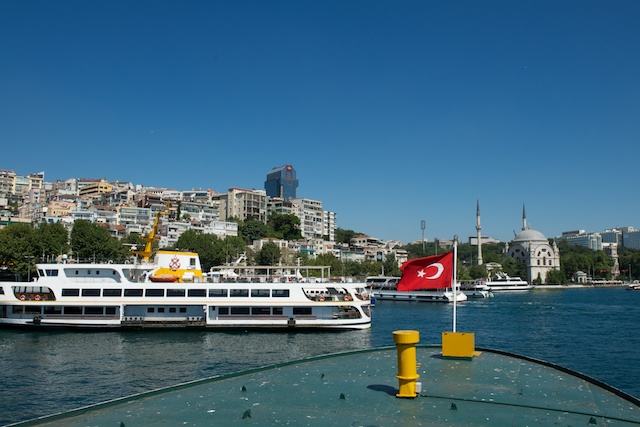 Donnie suggested that today we take a ferry to the Prince's Islands,
which had been recommended to her by someone she had met at the hotel.
We took the tram to the ferry terminal, and got on the ferry. The boat
was a large ferry, having three decks and lots of indoor and outdoor
seating. We went to the top deck and got some seats that were under a
roof and out of the sun. The ferry took 90 minutes and stopped at
several of the five islands.
Donnie suggested that today we take a ferry to the Prince's Islands,
which had been recommended to her by someone she had met at the hotel.
We took the tram to the ferry terminal, and got on the ferry. The boat
was a large ferry, having three decks and lots of indoor and outdoor
seating. We went to the top deck and got some seats that were under a
roof and out of the sun. The ferry took 90 minutes and stopped at
several of the five islands.
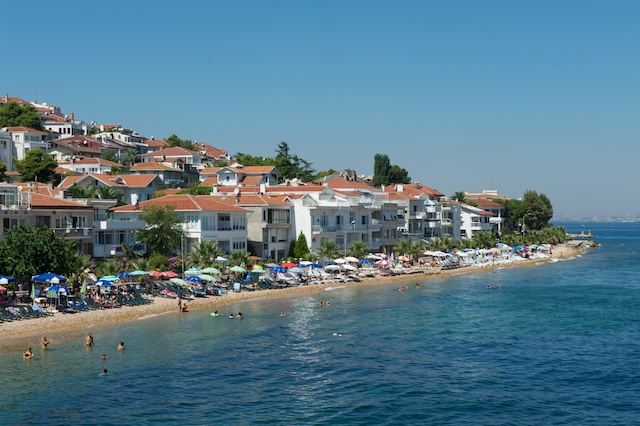 The first few islands were very small,
containing only a hill with some houses and a small beach. The last
island, called Buyukada, had a small village.
The first few islands were very small,
containing only a hill with some houses and a small beach. The last
island, called Buyukada, had a small village.
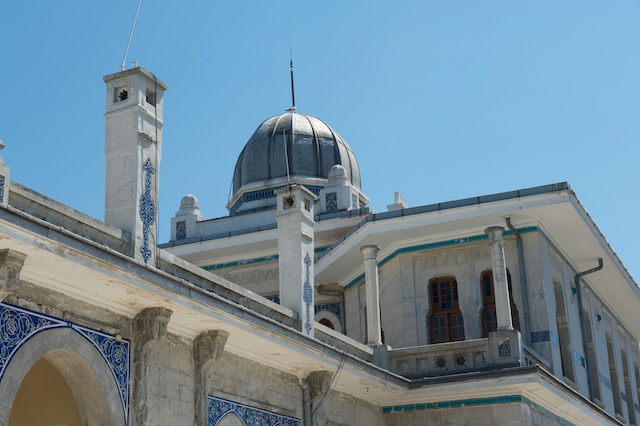 We got off the ferry, and
immediately were impressed by the ferry terminal building which was from
the 1800's and decorated in beautiful tiles. The village was clearly
set up for the tourists, containing many restaurants, snack places,
shops, etc. There were even fleets of horse-drawn carriages to take
people around the island.
We got off the ferry, and
immediately were impressed by the ferry terminal building which was from
the 1800's and decorated in beautiful tiles. The village was clearly
set up for the tourists, containing many restaurants, snack places,
shops, etc. There were even fleets of horse-drawn carriages to take
people around the island.
 We were told there were no cars on the
island, but there were a few delivery trucks. We did notice that here,
as in Istanbul, many deliveries were done via hand pushed carts, or even
by men carrying heavy loads on their backs. We wandered around the
village, taking pictures, and stopped for a small snack. We had found
that the heat prevented us from having much of an appetite for lunch.
In the afternoon, we got back on the ferry, found some seats on the top
deck that had a wonderful cooling breeze, and went back to Istanbul.
We were told there were no cars on the
island, but there were a few delivery trucks. We did notice that here,
as in Istanbul, many deliveries were done via hand pushed carts, or even
by men carrying heavy loads on their backs. We wandered around the
village, taking pictures, and stopped for a small snack. We had found
that the heat prevented us from having much of an appetite for lunch.
In the afternoon, we got back on the ferry, found some seats on the top
deck that had a wonderful cooling breeze, and went back to Istanbul.
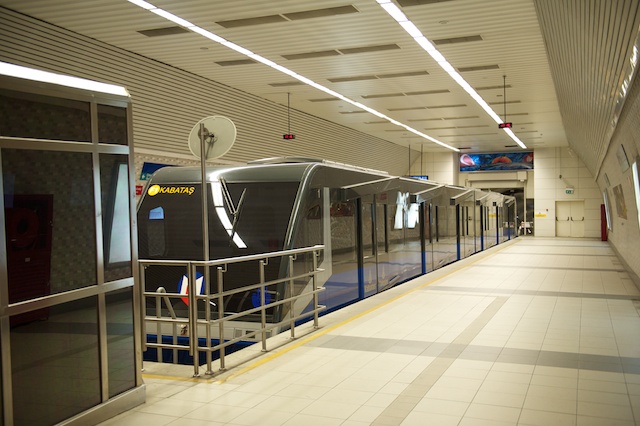 Donnie then suggested that we go to Taksim Square, since we were close.
Taksim is a modern commercial square, sort of like Times Square or
Piccadilly Circus. Since it was on a hill, and we were down by the
water, there was a funicular to go up to the square. Whenever I think
of a funicular, I picture a quaint wooden inclined train, usually very
old. No so here. The Taksim funicular was ultra-modern.
Donnie then suggested that we go to Taksim Square, since we were close.
Taksim is a modern commercial square, sort of like Times Square or
Piccadilly Circus. Since it was on a hill, and we were down by the
water, there was a funicular to go up to the square. Whenever I think
of a funicular, I picture a quaint wooden inclined train, usually very
old. No so here. The Taksim funicular was ultra-modern.
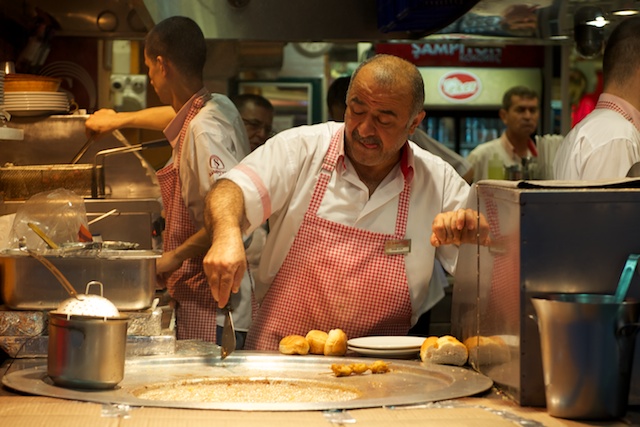
 The shops that interested us the most were the large number of food
places where you could watch through the window and see the cooks
preparing things. Donnie then took us to a place that she had been told
about by Chris, her younger son. It was called the Ara Cafe, and was a
nice, modern-decor restaurant with outdoor seating. The unusual thing
about the Ara Cafe is that it was named after, and owned by,
Ara Guler,
a famous photographer, in his eighties. The restaurant is decorated with
his magnificent black-and-white pictures of old Istanbul. He supposedly
still comes to the cafe every day. We ate there, and the food was
delicious. And then went to walk down Independence Avenue. The avenue is
at least a couple of miles long, and we walked the entire length. There
were many, many people there. When we got to the end, it was dark, and
we took the tram back to our hotel.
The shops that interested us the most were the large number of food
places where you could watch through the window and see the cooks
preparing things. Donnie then took us to a place that she had been told
about by Chris, her younger son. It was called the Ara Cafe, and was a
nice, modern-decor restaurant with outdoor seating. The unusual thing
about the Ara Cafe is that it was named after, and owned by,
Ara Guler,
a famous photographer, in his eighties. The restaurant is decorated with
his magnificent black-and-white pictures of old Istanbul. He supposedly
still comes to the cafe every day. We ate there, and the food was
delicious. And then went to walk down Independence Avenue. The avenue is
at least a couple of miles long, and we walked the entire length. There
were many, many people there. When we got to the end, it was dark, and
we took the tram back to our hotel.
We spent the morning revisiting the grand bazaar to get a few gifts and take a few more pictures. We then went back to the hotel early to pack, do some emailing, and rest.
 Oops! I nearly forgot about the cats! There are stray cats everywhere.
The authorities must allow this, maybe to deal with pests? Everywhere
you go there are stray cats. People eating in outdoor cafes feed them
while having dinner. We did too.
Oops! I nearly forgot about the cats! There are stray cats everywhere.
The authorities must allow this, maybe to deal with pests? Everywhere
you go there are stray cats. People eating in outdoor cafes feed them
while having dinner. We did too.
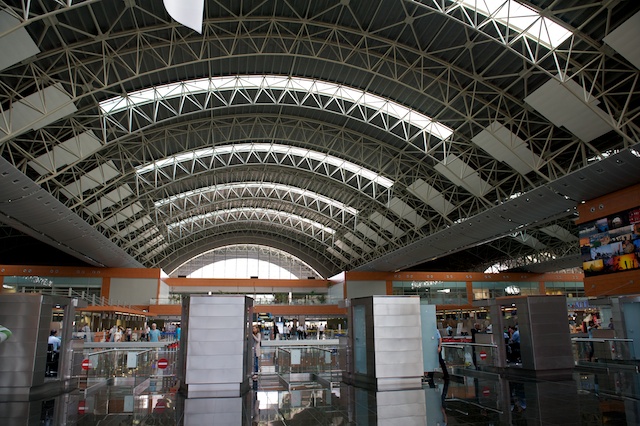 Friday was our travel day. Originally, when we booked the tickets for
the trip, months early, we were planning on going from Istanbul to
Greece, probably visiting a few greek islands. We had never been to
Greece, and wanted to visit. However, due to the economic unrest in
Greece, and the fact that we were tired of hot places, we changed our
plans and decided to go to some cooler spots. Like north-western Europe,
such as Holland, or Belgium. After checking online to find airline
tickets, we discovered that our options were limited, probably because
we had waited to almost the last minute to book the flights. We could
take a flight that left at 4:00 in the morning, requiring us to get up
about midnight (why bother to go to bed?). We could have flown at more
reasonable hours, at three times the price. Finally we found a flight at
a reasonable hour, at a reasonable price, however it was on a subsidiary
of Turkish Airlines, called AnodoluJet, and was leaving from another
airport, not Ataturk, the main airport serving Istanbul. We booked it,
hoping it would be ok. It was fine. The airport was an hour away, not
just 20 minutes like Ataturk, but when we got there, it was a large,
modern, beautiful, extremely clean airport. In fact, once again , the
floors in the terminal were spotless and highly polished. The flight
was a nice Boeing 737, and the food that they served onboard was better
than any US airline serves. Thank you AnodoluJet!
Friday was our travel day. Originally, when we booked the tickets for
the trip, months early, we were planning on going from Istanbul to
Greece, probably visiting a few greek islands. We had never been to
Greece, and wanted to visit. However, due to the economic unrest in
Greece, and the fact that we were tired of hot places, we changed our
plans and decided to go to some cooler spots. Like north-western Europe,
such as Holland, or Belgium. After checking online to find airline
tickets, we discovered that our options were limited, probably because
we had waited to almost the last minute to book the flights. We could
take a flight that left at 4:00 in the morning, requiring us to get up
about midnight (why bother to go to bed?). We could have flown at more
reasonable hours, at three times the price. Finally we found a flight at
a reasonable hour, at a reasonable price, however it was on a subsidiary
of Turkish Airlines, called AnodoluJet, and was leaving from another
airport, not Ataturk, the main airport serving Istanbul. We booked it,
hoping it would be ok. It was fine. The airport was an hour away, not
just 20 minutes like Ataturk, but when we got there, it was a large,
modern, beautiful, extremely clean airport. In fact, once again , the
floors in the terminal were spotless and highly polished. The flight
was a nice Boeing 737, and the food that they served onboard was better
than any US airline serves. Thank you AnodoluJet!
So we flew for 3 and ½ hours and arrived at... Schiphol Airport, Amsterdam!
Istanbul is a modern city, with some very old buildings. It is quite clean, and even though it is very crowded, seemed perfectly safe. Yes, there are some poor people around, but very, very few beggars. I don't remember much graffiti, if any. The trams are spotless, very modern and new, and only cost $1. In fact, visiting Istanbul was relatively inexpensive. At least in the Sultanahmet area, where most of the tourists are, the shopkeepers and restauranteurs spoke a little English (and possibly a little Italian and a little Spanish, and in one instance, a little Japanese!). Many signs are in Turkish and English.
The city was modern in some places, very old in others. They have done a good job of preserving the old while building the new. The sights and sounds are very different from "Western European" traditions, but not so unfamiliar as to be daunting. The people were mostly friendly. The sights were fascinating. It was quite different, I think, from the preconceptions I had and very pleasant. For me, the only downside to the experience was the heat, which could be oppressive, but I'm not a big fan of hot places in general. Next time we'll go in a different season. I do have to admit, though, that during this trip in August 2010, it was hotter in New York than in Istanbul!
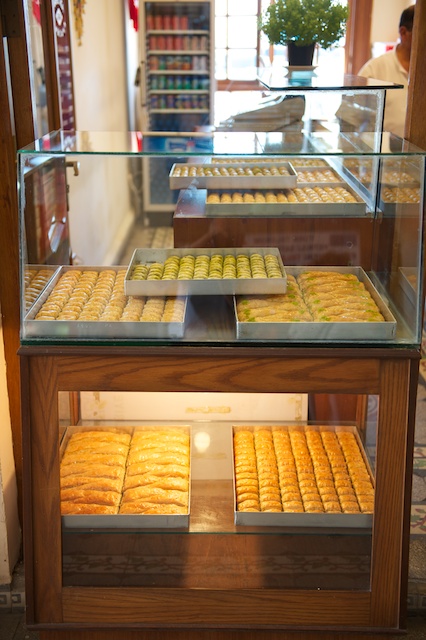
Ah yes, the title of this little epic. Baklava, for those who don't know, is a middle eastern pastry, made from many, many, thin layers of phyllo dough, with a layer of ground nuts, usually walnuts or pistachios, all soaked in sugar syrup. I love it. They sell it in many places in Istanbul, and, in fact, we found shops that sold nothing else. Yum!
Copyright © 2010 by Jeff Kravitz